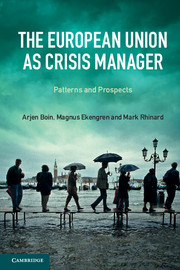2 - Assisting overwhelmed states
The evolving use of the Civil Protection Mechanism
Published online by Cambridge University Press: 05 August 2013
Summary
The Union and its Member States shall act jointly in a spirit of solidarity if a Member State is the object of a terrorist attack or the victim of a natural or man-made disaster.
(Article 222 of the Lisbon Treaty)Introduction: the gradual ascendance of the Civil Protection Mechanism
The earliest efforts to create joint crisis management capacity in the EU arguably date back to the 1970s. A set of now mostly forgotten disasters – who remembers Seveso and Amoco Cadiz? – prompted Commission officials to build what today is known as the Civil Protection Mechanism. This oddly titled organizational capacity helps member states deliver on the promise, captured in the Solidarity Clause of the Lisbon Treaty (cited above), of swift cooperation among national civil protection services in responding to natural or human-made disasters.
Since the first cautious steps were taken in the late 1970s, civil protection has emerged as a European policy domain – a “new European political space” (Stone Sweet, Fligstein, and Sandholtz 2001). The EU has in place a set of procedures and instruments that allow member states to coordinate and pool their resources in the face of disaster. Today, civil protection is explicitly mentioned in the Lisbon Treaty, it is a recognized EU policy area, and its products, as we will see, are increasingly “consumed” across the world.
- Type
- Chapter
- Information
- The European Union as Crisis ManagerPatterns and Prospects, pp. 21 - 51Publisher: Cambridge University PressPrint publication year: 2013

